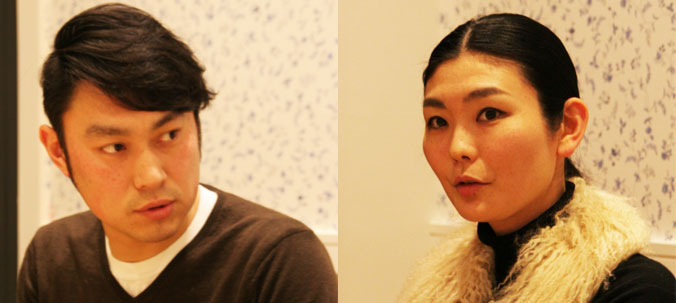“EN” Special Conversation vol.4
“EN” Special Conversation
Shuseki III Toru Horiguchi
Horiguchi Kiriko
Han Ahn Soon
Designer of HAN AHN SOON
[ URL ] Horiguchi Kiriko
[ URL ] HAN AHN SOON
For the final installation of the interview series featuring exhibiting companies and designers of the currently ongoing tradeshow/exhibition “EN,” where Japanese technologies encounter creators, we welcomed Horiguchi Kiriko Shuseki III Toru Horiguchi, who is gathering attention for his detailed and minimalistic touch in the world of Edo Kiriko cut glass, which is particularly popular among traditional crafts, and Ms. Han of the popular brand HAN AHN SOON, which expresses feminine beauty and strength using rich colors and bold designs. We talked to them about the product that they made for the exhibition, as well as episodes behind the production and their respective stances in their creations.
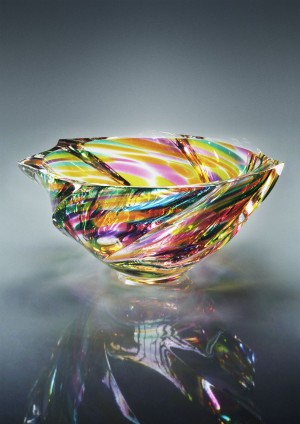
Niji no Tamoto / Shuseki III
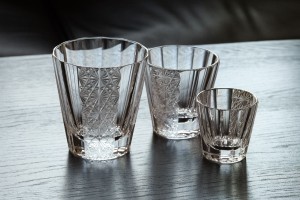
Kikushige / Shuseki III
First,Mr. Horiguchi, can you introduce to us your past activities?
Horiguchi: Originally, my parents own a company called Horiguchi Glass, which makes Edo Kiriko cut glass, so for the first nine years, I trained there, and in 2008 I succeeded the name “Shuseki” and started my own company. Horiguchi Glass is characterized by traditional products, the type which comes to mind when you think of Edo Kiriko. Personally, I love traditional products as well, but when I became independent, I wanted to express my unique taste. After I became independent, I started to work on things that I was interested in, but now, I have more opportunities to be involved in projects that have a relatively high degree of freedom, and so I always have a fresh mind when doing my work.
Han: I myself only had the image of red and blue glass when I thought of Edo Kiriko, much like everyone else, so I was able to learn many things through our collaboration.
Horiguchi: As Ms. Han says, I think the colors and sparkle that many people imagine when they think of Edo Kiriko is one of its characteristics. Also, I think that all types of glass have the appeal of being influenced in a good way by the surrounding conditions, such as food and drinks, the table, the background, and light, etc., because it is a transparent material. Edo Kiriko is cut glass, so I think that the feel of its unevenness is also an element that can be enjoyed, and when I make my products, I also place value on how easy it is to actually use, such as the size, and thickness of the rim.
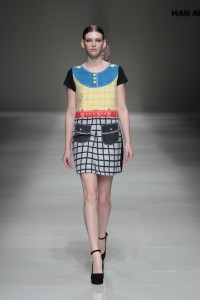
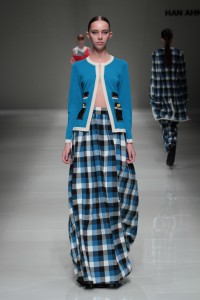

HAN AHN SOON 2014 S/S
Do you often collaborate with companies in different industries such as for this project?
Horiguchi: Not very often. It seems that such collaborations would be easy due to the fact that glass is easily influenced by the surrounding environment, as I just mentioned, but Edo Kiriko has a lot of technical restrictions in terms of cut and color, etc. That was the difficult part for this collaboration as well.
Han: There were more things that we could not do than I had expected (laughs). HAN AHN SOON is a brand that places value on colors, so I was hoping to be able to express that, but the types of colors of Edo Kiriko are very limited, and even if you take just a single color, like red, there are not many varieties of it. It was also technically challenging to depict two-tone colors and there were many difficulties, but I aimed to express the feminine pop-ness that is characteristic of HAN AHN SOON.
Horiguchi: What we first discussed was whether to take the direction of me handing Ms. Han processed pieces that she could then use to make clothing, etc., or conversely to express Ms. Han’s world view in Edo Kiriko. We ultimately decided to do the latter, but in this case, I would be mainly in charge of creating the product, so I couldn’t help the fact that my individuality would be expressed in the details. Therefore, the most important point was how to express Ms. Han’s world view and what she thought looked good to the extent possible, and so we worked on finding the greatest common denominator between Ms. Han’s image and what was possible with Edo Kiriko.
Han: When I make clothes, I do everything from choosing the material to working on the details, but for this project, I had no knowledge about glass and could only throw out ideas, so it was very different from usual. For instance, with my clients, I sometimes receive requests regarding the product, but often the requests are not realistic, for instance, realizing them would increase costs tremendously. This time, I feel like I was closer to being in the client’s position.
Horiguchi: I felt really bad having to reject ideas that Ms. Han came up with (laughs). There is a certain level of finish and processing that I have set in my mind and I cannot go under that level, and on the other hand, there are difficulties in terms of realization due to cost. This really limited what we were able to do, and halfway through there were times where I felt that we had wandered into a maze. However, what I wanted to avoid was to say “we can do it” and then end up with something that was completely different from what we had imagined—this sometimes happens on the job. I definitely did not want to lie, and I thought that nothing would be created by doing so.
Han: I strongly felt Mr. Horiguchi’s persistence as a craftsman in his attitude. There were many restrictions, but I think that we were still able to achieve pop-ness and cuteness that is characteristic of HAN AHN SOON.
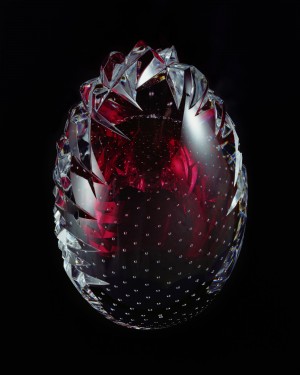
several elements / Shuseki III
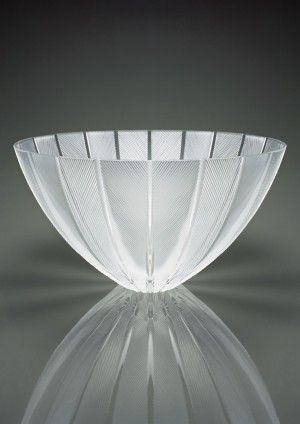
kizami / Shuseki III
What kind of product did you ultimately end up with?
Han: We are making an Edo Kiriko glass printed with dots in colors such as gold, silver, and pink.
Horiguchi: I cut a pattern representative of Edo Kiriko called Kiku-tsunagimon. This time, I wanted to place importance on the image that many people have of Edo Kiriko as having many fine cuts, and it is also an auspicious pattern since you can write the name of the pattern using characters that mean “to pass on happiness for years and years.” This time, we are making a wooden box with a polka-dot print especially for this project, but even for the box, I focused on details such as the corners. In the world of fashion, where Ms. Han works, I think it is natural to be fixated on everything down to the packaging as well, but in our industry, I don’t think people are too fastidious about that part. However, I think that it is necessary to express our world view as a whole package that includes the packaging, rather than just the kiriko glass itself.
Han: By working with Mr. Horiguchi, I learned a lot about how different industries work in such different ways, and I think it was a really good opportunity. Many people have done collaborations in the past, and I think that the scope of our creations broadens by being able to gain fresh inspiration through such opportunities, and I hope that this will in turn inspire the people who receive these creations, thereby continuing the chain.
Were you conscious of anything in particular because of the fact that this product would be exhibited at an event held during the fashion week session?
Horiguchi: Since we created something in my field of Edo Kiriko for this project, I strongly felt the desire to create something that people in the fashion industry would immediately know was Ms. Han’s design when looking at the product. Also, I wanted to convey the flexibility of traditional crafts to people who do not usually have the opportunity to see Edo Kiriko. I think that traditional crafts remain today because they change flexibly in accordance with what is desired at the time. Of course, some things remain unchanged, such as the fine cut and beautiful colors characteristic of Edo Kiriko. I feel that while we should inherit such skills and inner aspects, we should always be flexible in terms of the mode of expression and be sensitive about what the user desires at this moment.
Han: In the case of fashion, often things are created earlier than what is required by the times. It is important to also create products that actually sell, but on the other hand, we also put a lot of effort into creating items that do not sell well, such as showpieces. This is an important part of fashion that gives people dreams and feelings of longing, and I want to continue to work on this. Many of the designers of brands that are participating in Tokyo Fashion Week have a spirit of challenge when working on their creations, and I think that in this aspect, we are top class in the world.
Horiguchi: The other day, I participated in a joint exhibition in New York for the first time, and I found it to be very inspiring and I received good responses as well. People’s reactions abroad differ from those in Japan—even if a person does not know the creator’s background or title, or does not know about the characteristics of Edo Kiriko, for instance, they make a direct decision of whether or not they like the piece of work in front of them. In this sense, I felt that maybe it is necessary to slightly change our approach for items intended for international clients. I am happy when something that I made in Japan is sold and well received abroad, and if I have the opportunity, I would like to get more international exposure in the future as well.

Text by Yuki Harada


